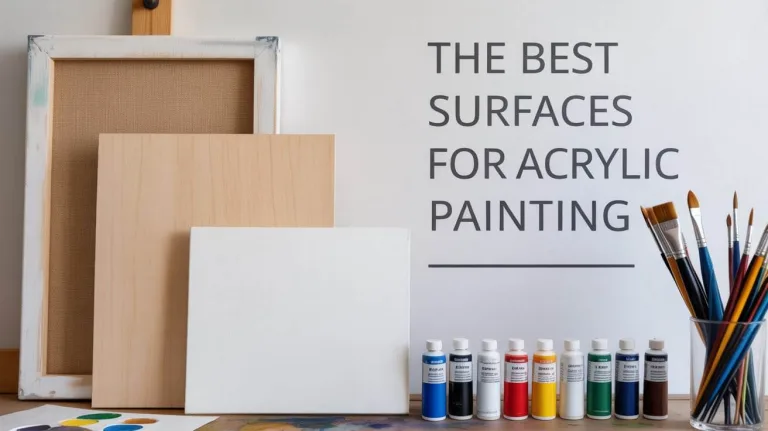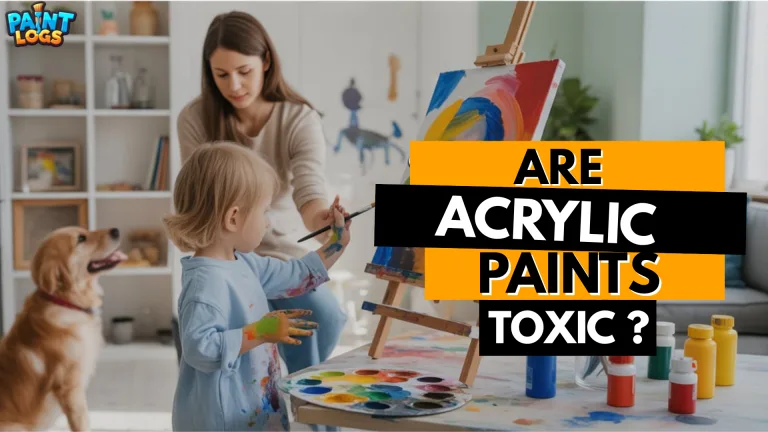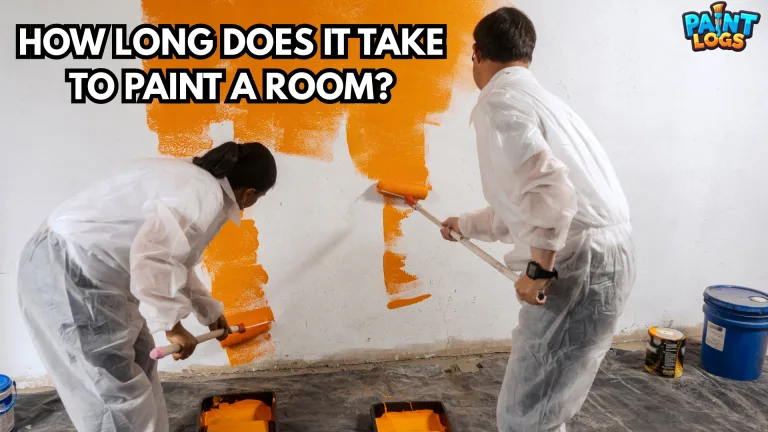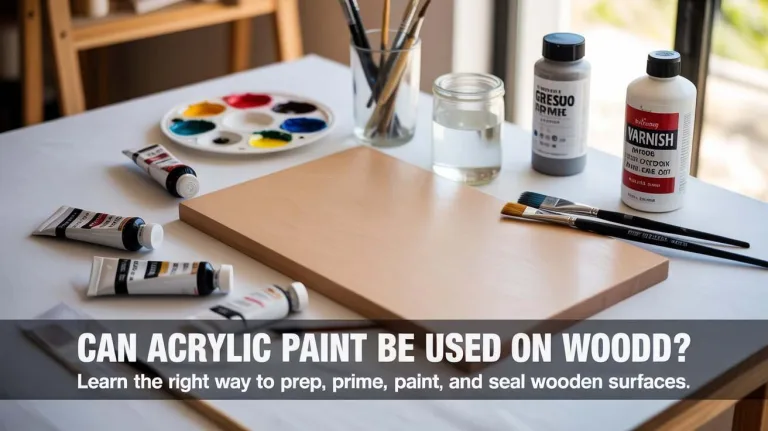If you’ve ever painted a canvas, decorated a wooden sign, or even added designs to fabric, you’ve probably asked yourself: is acrylic paint waterproof? The short answer is no — acrylic paint is water-resistant, not fully waterproof. When dry, it forms a flexible plastic-like film that can handle splashes of water, but if left in the rain, washed in a machine, or exposed to constant moisture, the paint will eventually soften, fade, or peel away.
That’s why artists, DIY crafters, and homeowners often wonder: is acrylic paint waterproof when dry, is acrylic paint waterproof once dry, or is acrylic paint waterproof after it dries? These questions all boil down to one fact: acrylics need sealing if you want true waterproof protection.
In this guide, we’ll explore how acrylic paint reacts to water, how it performs on different surfaces like wood, fabric, clothes, rocks, glass, and plastic, and how to make your projects last outdoors.

Understanding Acrylic Paint and Water Resistance
Acrylic paint is made from three main ingredients: pigment (for color), a water-based binder (usually an acrylic polymer emulsion), and additives for flow or texture. When wet, it behaves like a water-based paint — easy to thin and clean up with soap and water. Once it dries, the water evaporates, leaving behind the plastic-like acrylic polymer that holds the pigment in place.
This is why people assume acrylics are waterproof. The dried layer feels tough, flexible, and resistant to light splashes. But here’s the important difference:
- Water-resistant means it can resist some contact with water without damage.
- Waterproof means it can withstand continuous water exposure without breaking down.
By this definition, acrylic paint is not waterproof, even after it dries. Without a topcoat or sealant, rain, washing, or long-term moisture will eventually damage it.
For example:
- Acrylic paint on clothes or fabric will fade in the wash unless you mix it with a fabric medium or heat-set it.
- Acrylic paint on wood may peel outdoors unless sealed with varnish or polyurethane.
- Acrylic paint on rocks, glass, or plastic looks great for crafts, but it needs sealing sprays or epoxy to stay waterproof.
In short, acrylic paint is versatile and durable — but only water-resistant by default, not truly waterproof.

Does Acrylic Paint Become Waterproof When Dry?
A common belief is that once acrylic paint dries, it becomes waterproof. This isn’t quite true. When acrylic paint dries, it becomes water-resistant, not waterproof. The difference is important.
When the paint dries, the water inside the mixture evaporates, leaving behind a layer of acrylic polymer (a type of plastic). This film is flexible and strong, which is why acrylics are so durable compared to watercolors or tempera paints. However, if exposed to enough water — such as heavy rain, constant splashing, or a washing machine cycle — the paint film can soften or break down over time.
So if you’re asking is acrylic paint waterproof when dry, is acrylic paint waterproof once dry, or is acrylic paint waterproof after it dries — the answer is:
- No, not by itself. Drying alone does not make acrylic waterproof.
- The paint becomes permanent on most surfaces, but not invincible against water.
- A sealer, varnish, or fabric medium is needed to make it waterproof for outdoor or washable use.
Think of it this way: acrylic paint forms a thin, plastic-like coating when dry. Plastic itself repels water to a degree, but over time, even plastic can crack, peel, or wear down with weather, scrubbing, or soaking. That’s why sealing is key if your project will face water exposure.
Curing vs. Drying
Another detail many overlook is the difference between drying and curing:
- Drying means the surface feels dry to the touch, often within 15–30 minutes.
- Curing means the paint has fully hardened all the way through — this can take 24–72 hours, or longer for thick layers.
Until acrylic paint is fully cured, it’s especially vulnerable to water damage. That’s why experts recommend waiting at least a few days (sometimes weeks) before sealing your work.

How Durable Is Acrylic Paint on Different Surfaces?
Acrylic paint sticks well to almost any surface, but its level of water resistance changes depending on where it’s applied. Here’s how it behaves across the most common surfaces artists and DIYers ask about.
Fabric and Clothes
Many people ask is acrylic paint waterproof on clothes or fabric? By default, it isn’t. Acrylic is water-based, so it will fade, crack, or wash out after a few trips through the laundry. If you want acrylic paint to last on fabric, you’ll need to use one of these methods:
- Fabric medium – Mix your acrylic with a textile or fabric medium before painting. This keeps the paint flexible, prevents cracking, and helps it bond to fabric fibers.
- Heat setting – Once dry, iron the reverse side of the fabric (with a cloth in between to protect the paint). Heat setting “locks” the pigment into the fibers, making it far more washable.
- Fabric sealers – Some crafters use clear acrylic sealers or Mod Podge for fabric projects, though this can leave a stiff finish.
On raw clothes, acrylic is not waterproof when dry — but with fabric medium and heat, it can survive regular washing.
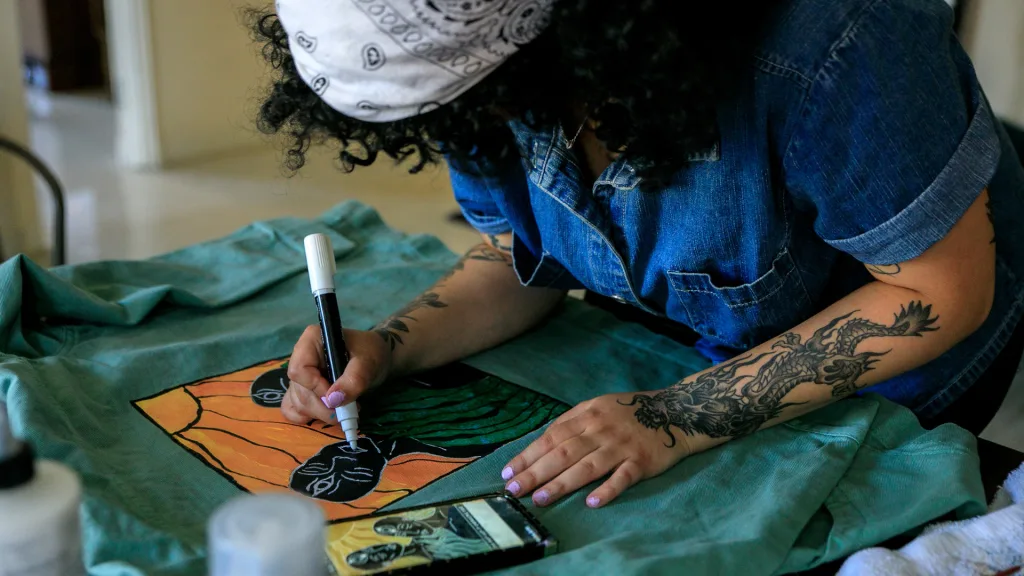
Wood
If you’re painting wooden signs, furniture, or crafts, you may wonder is acrylic paint waterproof on wood? The answer is: acrylic bonds well to wood but needs sealing, especially outdoors.
- Unsealed wood absorbs water, which can cause acrylic layers to peel.
- For indoor wood projects, a coat of clear varnish or polyurethane after painting is enough.
- For outdoor wood projects, always prime the surface first (with gesso or wood primer) and apply multiple coats of outdoor varnish or polyurethane for waterproofing.
Without sealing, painted wood left in rain or high humidity will eventually chip and crack.

Plastic
Plastic is trickier. People often ask is acrylic paint waterproof on plastic? — but before waterproofing, you first need the paint to stick. Acrylic doesn’t naturally bond well to smooth plastic.
Here’s how to improve adhesion:
- Sand the plastic lightly to create texture.
- Apply a plastic primer (or gesso for crafts).
- Paint with acrylic.
- Finish with a waterproof acrylic sealer spray or resin.
Without these steps, the paint may flake off long before water even becomes an issue.
Rocks and Stone
Rock painting is a popular craft, and beginners often wonder is acrylic paint waterproof on rocks? Acrylic sticks beautifully to porous surfaces like stone, but it will wear down outdoors unless sealed.
- For indoor rock art, a simple varnish or Mod Podge is fine.
- For outdoor garden rocks, use a strong clear spray sealer or resin to protect from rain, snow, and UV rays.
This makes painted rocks last for years outside without fading or peeling.

Glass and Ceramics
Another common question: is acrylic paint waterproof on glass? On its own, no. Glass is non-porous, so acrylics can peel or wash off unless properly set. Two options work best:
- Sealing sprays or varnishes – Apply a clear acrylic sealer over the dried design.
- Baking method – For glassware or ceramics, you can bake the piece in the oven (usually around 350°F/175°C for 30 minutes). This helps fuse the paint to the glass surface, making it much more water-resistant.
Even then, acrylic-painted glass isn’t dishwasher-safe — gentle hand washing is best.
Can You Use Acrylic Paint Outdoors?
One of the most-searched questions is is acrylic paint waterproof for outdoors? The answer is: not without protection. Acrylics can handle mild exposure to weather, but rain, humidity, and sunlight all take their toll over time.
- Rain & Moisture: Prolonged rain or standing water will eventually soften acrylic layers. Outdoors, unsealed paint may bubble, peel, or flake within weeks.
- Humidity: In damp climates, wooden or porous surfaces underneath can expand and contract, causing the paint to crack.
- UV Rays: Sunlight is just as damaging as water. Over months, UV rays break down pigment, causing fading (especially with colors like reds and yellows).
If you’re asking will acrylic paint wash off in the rain? — yes, eventually, unless sealed. That’s why outdoor artists, muralists, and crafters always use a combination of primer + paint + topcoat.
For best results outdoors:
- Use outdoor-grade acrylics (Golden Heavy Body, Liquitex, or craft brands like DecoArt Patio Paint).
- Apply to a primed surface (wood, wall, or stone).
- Seal with an outdoor varnish, polyurethane, or epoxy resin.
With the right preparation, acrylic paint can last years outdoors, but on its own, it is only water-resistant, not waterproof.

How to Make Acrylic Paint Waterproof
Since acrylic paint doesn’t start out waterproof, the real question becomes: how do you waterproof it? Luckily, sealing acrylic paint is simple and inexpensive.
Here’s a step-by-step guide:
- Prepare the Surface
- Prime porous surfaces (wood, canvas, concrete) with gesso or primer.
- Sand and prime smooth surfaces like plastic or metal.
- Apply the Acrylic Paint
- Paint in thin, even layers.
- Let each coat dry fully before adding another.
- Allow at least 24–72 hours for curing before sealing.
- Choose the Right Sealer
- Varnish: Brush-on varnish works well for canvases and wood.
- Spray Sealers: Great for rocks, outdoor furniture, or crafts.
- Resin/Epoxy: Creates a hard, glossy, waterproof finish (popular for tabletops or coasters).
- Mod Podge (Outdoor Formula): A DIY favorite for crafters.
- Seal the Paint
- Apply multiple thin coats of your chosen sealer.
- Allow proper drying time between coats.
- For outdoor projects, choose UV-resistant sealers to prevent fading.
By sealing, you can make acrylic paint waterproof on wood, plastic, rocks, fabric, or glass. Without this final step, even fully dried acrylic remains vulnerable to water damage.

Common Misconceptions About Waterproof Acrylic Paint
Because acrylic dries into a plastic-like film, it’s easy to believe it’s automatically waterproof. But there are several myths floating around that confuse beginners.
- Myth 1: Acrylic paint is waterproof when dry.
Not true. It’s only water-resistant. If you soak a painted surface, the paint can soften and peel. - Myth 2: All acrylic brands are the same.
Craft acrylics like Apple Barrel or FolkArt are cheaper but less durable outdoors than professional brands like Golden or Liquitex. Some specialty paints, like DecoArt Patio Paint, are formulated to be more weather-resistant, but they’re still not 100% waterproof without sealing. - Myth 3: Any varnish makes acrylic waterproof.
Not every topcoat works well. Some varnishes contain solvents that can damage acrylics. Others may not protect against UV or moisture outdoors. Always choose a varnish or sealer specifically labeled for acrylic paint. - Myth 4: Once sealed, acrylic lasts forever.
Even with sealing, outdoor conditions eventually wear paint down. Waterproofing makes it last much longer, but no coating is truly permanent.
By clearing up these myths, you’ll understand that acrylic paint needs proper prep + sealing to survive rain, washing, or outdoor conditions.
Wrap Up: Water-Resistant, Not Waterproof
So, is acrylic paint waterproof? The answer is simple: acrylic paint is water-resistant when dry, but not fully waterproof. On its own, it can handle light splashes or a bit of moisture, but constant rain, washing, or soaking will eventually break it down.
Here’s what to remember:
- When dry: Acrylic forms a durable, plastic-like film.
- On clothes and fabric: Not waterproof — needs fabric medium and heat-setting.
- On wood, plastic, rocks, or glass: Sticks well but always needs priming and sealing.
- Outdoors: Great choice if sealed with the right varnish, resin, or polyurethane.
If you want your artwork, furniture, or craft projects to last, don’t stop at just painting. Seal your acrylics with a good-quality varnish, spray sealer, or resin. That final step makes the difference between paint that fades in weeks and paint that looks good for years.
In short, acrylic paint is one of the most versatile mediums out there — but to make it truly waterproof and weatherproof, sealing is essential.
Q/As
Q: How long does acrylic paint last outdoors without sealing?
Acrylic paint outdoors may begin to fade, peel, or soften within weeks if exposed to rain or heavy sun. On average, unsealed acrylic on wood or stone can last 1–3 months, while sealed projects can last years with proper protection.
Q: Can you make acrylic paint waterproof without varnish?
Not fully. Varnish or polyurethane is the most reliable method. Some crafters use Mod Podge Outdoor or resin coatings, but without a protective layer, acrylic paint will always stay only water-resistant, not waterproof.
Q: Is acrylic paint waterproof on shoes?
No. On fabric or leather shoes, acrylic paint cracks or washes away if left unsealed. To make it last, mix with a fabric medium, apply thin coats, and finish with a waterproof shoe sealer spray.
Q: Can you waterproof acrylic paint on fabric with an iron?
Yes. Heat-setting acrylic mixed with fabric medium using an iron helps lock the color into fibers, making it washable. Place a thin cloth between iron and paint to protect the design.
Q: Is acrylic paint waterproof on canvas without varnish?
Acrylic on canvas is fairly durable indoors, but humidity can still damage it. For long-term protection against dust and moisture, artists usually apply a UV-resistant varnish.
Q: Does sealing acrylic paint also protect against UV damage?
Yes. Many outdoor sealers are UV-resistant and prevent fading from sunlight. Regular clear sealers may protect against moisture but not UV rays, so choose one designed for outdoor durability.
Q: Can you waterproof acrylic paint with hairspray?
Hairspray isn’t a good option. It may temporarily protect small crafts, but it becomes sticky, attracts dust, and eventually breaks down. Use an acrylic-safe sealer instead.
Q: Is acrylic paint dishwasher-safe after sealing?
No. Even sealed acrylic paint on glassware or ceramics isn’t safe for dishwashers. Gentle hand washing is the only way to make painted glass last.
Q: Is acrylic paint waterproof on metal?
Not by itself. On bare metal, acrylic may chip or peel. For best results, prime with a metal primer, then seal with clear enamel spray for outdoor durability.
Q: Can you mix acrylic paint with waterproof mediums?
Yes. Adding fabric medium (for clothes), pouring medium (for resin-like finishes), or outdoor acrylic mediums can improve flexibility and durability, but sealing is still recommended.
FAQs
Is acrylic paint water-resistant?

Yes, acrylic paint becomes water-resistant after drying. It won’t wash off with a light splash, but it isn’t fully waterproof without sealing.
Is acrylic paint waterproof after it dries?
No. Drying alone does not make acrylic waterproof. To protect it from rain or washing, you must add a clear coat or varnish.
Will acrylic paint wash off in rain?
If unsealed, yes. Constant rain or outdoor exposure will eventually cause it to fade, crack, or peel.
Is acrylic paint waterproof on fabric or clothes?
No. On its own, acrylic washes out of clothes. Use fabric medium + heat-setting to make it machine-washable.
Is acrylic paint waterproof on wood?
Not by itself. Always prime and then seal wood projects if they’ll face water or humidity.
Is acrylic paint waterproof on glass?
No. Acrylic can flake off smooth glass unless baked or sealed with clear varnish.
Is acrylic paint waterproof on plastic?
No. Plastic requires sanding + priming first, and sealing afterward, to prevent peeling.
What paint is truly waterproof?
Oil-based paints, epoxy paints, and specialty outdoor paints are far more waterproof than acrylics. Acrylic can last outdoors if sealed properly, but it’s not inherently waterproof.
Do you need to seal acrylic paint on canvas?
Not required for indoor display, but sealing helps preserve color vibrancy and protects against moisture or dust.




